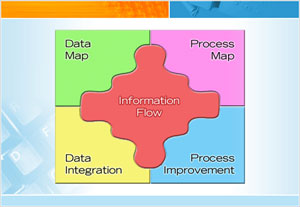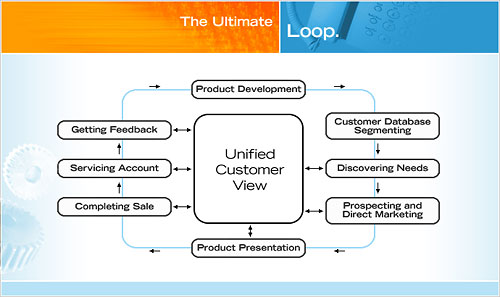Step Two
Match organizational needs and workflow processes to technical functionality needed to work across networks and business units.
Once you have a definition of the long term goals specific to each business unit, you need to know which departments handle that information, what their processes are and finally, what features might be able to integrate and work with the information in a meaningful way. Only then is it time to sort out how each feature and functionality will be acquired, either through off-the-shelf technologies or built as a customized application.
Why so much detail upfront? Imagine a company named ZZStor that sells data storage products through channel partners that ultimately are installed by systems integrators. They need to develop an extranet that allows password-protected access for several audiences to multiple offerings:
- Product News (Available to all)
- Events (Some open to the sales department, others to the service department, others to channel partners)
- Training (online training open to certified service technicians)
- Sales-incentive programs (For inside sales only)
- Technical product details (For sales, channel partners and integrators)
- Technical Service (Only for Systems Integrators and Installers)
Suppose a channel partner lands a big deal in Germany. The field rep logs on to place the order and starts in motion a string of automated processes across several networks. The field rep clicks "Submit" and triggers rules about configuring bundled products to fulfill the order; it checks ZZStor's inventory and the inventory of companies who make the other bundled components of the overall system. Four companies now have purchase orders with the same end user shipping address and channel partner purchasing information. That means it goes into ZZStor's billing system, the channel partner database and the end-customer database. The field rep checks off which systems integrator will be handling the deal, and a notification is sent to ZZStor's installation team in Germany that the order will be arriving in three weeks. It checks their schedules and books an installation date, then sends a confirmation back to the field rep. This transaction qualifies the channel partner for higher levels of co-op marketing, and its marketing department receives the good news from ZZStor's channel marketing system.
This system is not fantasy. It is at work today in one of the largest data storage companies in the world. The point is that a series of networks are linked by a relationship management system tied to several levels and categories of relationships. We mention this to emphasize the importance of knowing who handles which information and for what purposes. You can't get to this level of integrated workflow automation without mapping today's reality and tomorrow's dream.
The Ceonex Assessment Process is based for the most part on Dick Lee's practical approach outlined in his seminal book, "Strategic CRM: The Complete Implementation Manual." Here's a overview of how to go about this:
Data map:
Look at how customer information flows through the organization from the point of entry to either a full customer profile or dead account. It might help you to visual flow charts for each customer.. Although it might seem like purely transactional data, also consider warranty use data, customer service logs (to see what customers or types of customers use the most resources after the sale), or sales and marketing data. For example, you might notice that the information about customers in marketing's prospect database for a year differs from the information in the sales department about customers who made quick purchases. Such differences might point to either a breakdown in information flow between the two departments or to a difference in the behavior of customers. Did they buy different things or more things? Did they eat up more resources before or after the sale that affects their profitability?
Process map:
Build a process map that overlays your data maps to see how customer information is moved through your organization and who moves it. This can be a very arduous process, but one that promises huge rewards. Inevitably you will find dead pockets of information where valuable facts about customers are not being shared with other business units that could benefit from them. Or business-to-business industries might find that separate departments are attempting to gather the same information from different departments of the same customer-and getting different results! One of the easiest ways to think about mapping a process comes from an example of a local chamber of commerce who set out to prove that tourist dollars flow through the town's economy with an impact. They started by giving a few local tourist attractions $10,000 in $2 bills to hand out while making change. By the end of the first week, every business in town was flush with $2 bills. The same principal applies when trying to decide which data are meaningful and trying to map the processes by which that data moves through the organization. Once you map the processes, you will start to see opportunities for improvement.
Process analysis:
CRM will affect most processes in your organization. Start with an analysis of how processes within departments are tied to other departments. Identify inefficiencies, then develop a strategy to improve those processes. Don't waste time fixing a bad process, and never automate an inefficient process. Often, the lowest level employees have the greatest affect on processes affecting data, in terms of quality and flow. Sales people are notorious for creating bottlenecks of prospect and customer information, partly because of the kinds of personalities drawn to sales careers (not necessarily detail and process-oriented), and often because of a lack of prescribed processes to guide them.. For example, inaccuracies in contact information, plague sales and marketing departments when a sales person has typed in partial or incorrect information that the marketing department wants to use for cross-promotional or loyalty-building purposes. It's tough to maintain your credibility when the "personalized" form letter is sent to Ms. Carol Smith when it's Mr. Carole Smith, the founder of the company, who should be reading that expensive mailing. Process will prove priceless.
Data Integration:
Where is your data spread throughout the organization and who controls it? Find separate prospect and customer data repositories and develop a strategy to link them. You need to create the "Ultimate Loop" of customer data: create a process to gather all contact information, purchase history, product preferences, and correspondence gathered during the relationship and make it all accessible to all departments.. For example, at the front end of the organization, marketing buys a prospect company's contact information, feeds it to sales, which tracks down the right contacts and makes the sale. The sales department provides billing and shipping information to the billing department that sends an invoice to the customer. The service department records warranty, maintenance and product feedback information, and passes that along to the R&D folks developing new products. R&D would like to know what the engineer from that last client company had to say about the latest design change. All this information needs to be integrated into a single customer view so that all departments can see what all the departments of the client's company have said and done that affect the relationship. On the consumer side, it might be a matter of trying to consolidate information from the call center, the Web site and the service center so that customer communication ends up in one destination so that any customer service representative interacting with a customer will know the complete history of the relationship.

Drafting detailed technical specifications and a development plan
Once your assessment process has defined the organizational needs, drafting detailed technical specifications is a top priority. The goal is to prioritize elements of the project to enable the team to start to define the probable phases of the project.
There are two deliverables from this process: detailed technical and functional specifications and a detailed development plan. Specifications outline the applications needed to achieve the business goals identified earlier (for both internal and external applications). The most complicated solutions will require the most discovery process, and probably will be the last to be started. Much of the initial discovery process will determine future approaches and costs.
The development plan will be drawn from an outline of the information architecture and the data flow between departments (and systems), and ultimately will place each development task in sequence for the overall project. In this plan, corporate priorities help define the phases so that the top priorities get attended to, regardless of whether the urgency stems from highest short-term ROI or the need to curb customer attrition. Of course, infrastructure also plays a role in the order of development tasks, in the sense of building the foundation before the applications running on it. The planning process involves establishing time frames for each task, layering the start dates to match launch dates that dovetail with the right infrastructure being in place. Any development firm worth its salt will share a Gantt chart with you that depicts start and finish dates for key elements of each phase with milestones tied to specific dates and responsibilities assigned to specific people or teams (both internal and external). That document will enable you to ensure the developers hit their mark.

